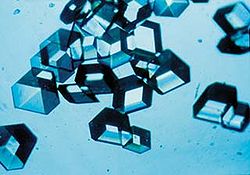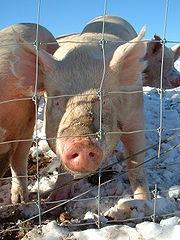
Use of biotechnology in pharmaceutical manufacturing
Encyclopedia
.jpg)
Biotechnology
Biotechnology is a field of applied biology that involves the use of living organisms and bioprocesses in engineering, technology, medicine and other fields requiring bioproducts. Biotechnology also utilizes these products for manufacturing purpose...
.
Human Insulin

Recombinant DNA
Recombinant DNA molecules are DNA sequences that result from the use of laboratory methods to bring together genetic material from multiple sources, creating sequences that would not otherwise be found in biological organisms...
technology to modify Escherichia coli
Escherichia coli
Escherichia coli is a Gram-negative, rod-shaped bacterium that is commonly found in the lower intestine of warm-blooded organisms . Most E. coli strains are harmless, but some serotypes can cause serious food poisoning in humans, and are occasionally responsible for product recalls...
bacteria to produce human insulin
Insulin
Insulin is a hormone central to regulating carbohydrate and fat metabolism in the body. Insulin causes cells in the liver, muscle, and fat tissue to take up glucose from the blood, storing it as glycogen in the liver and muscle....
, which was performed at Genentech
Genentech
Genentech Inc., or Genetic Engineering Technology, Inc., is a biotechnology corporation, founded in 1976 by venture capitalist Robert A. Swanson and biochemist Dr. Herbert Boyer. Trailing the founding of Cetus by five years, it was an important step in the evolution of the biotechnology industry...
in 1978. Prior to the development of this technique, insulin was extracted from the pancreas
Pancreas
The pancreas is a gland organ in the digestive and endocrine system of vertebrates. It is both an endocrine gland producing several important hormones, including insulin, glucagon, and somatostatin, as well as a digestive organ, secreting pancreatic juice containing digestive enzymes that assist...
glands of cattle, pigs, and other farm animals. While generally efficacious in the treatment of diabetes, animal-derived insulin is not indistinguishable from human insulin, and may therefore produce allergic reactions. Genentech researchers produced artificial gene
Gene
A gene is a molecular unit of heredity of a living organism. It is a name given to some stretches of DNA and RNA that code for a type of protein or for an RNA chain that has a function in the organism. Living beings depend on genes, as they specify all proteins and functional RNA chains...
s for each of the two protein
Protein
Proteins are biochemical compounds consisting of one or more polypeptides typically folded into a globular or fibrous form, facilitating a biological function. A polypeptide is a single linear polymer chain of amino acids bonded together by peptide bonds between the carboxyl and amino groups of...
chains that comprise the insulin molecule. The artificial genes were "then inserted... into plasmids... among a group of genes that" are activated by lactose
Lactose
Lactose is a disaccharide sugar that is found most notably in milk and is formed from galactose and glucose. Lactose makes up around 2~8% of milk , although the amount varies among species and individuals. It is extracted from sweet or sour whey. The name comes from or , the Latin word for milk,...
. Thus, the insulin-producing genes were also activated by lactose. The recombinant plasmids were inserted into Escherichia coli bacteria, which were "induced to produce 100,000 molecules of either chain A or chain B human insulin." The two protein chains were then combined to produce insulin molecules.
Human Growth Hormone

Growth hormone
Growth hormone is a peptide hormone that stimulates growth, cell reproduction and regeneration in humans and other animals. Growth hormone is a 191-amino acid, single-chain polypeptide that is synthesized, stored, and secreted by the somatotroph cells within the lateral wings of the anterior...
, the hormone was manufactured by extraction from the pituitary gland
Pituitary gland
In vertebrate anatomy the pituitary gland, or hypophysis, is an endocrine gland about the size of a pea and weighing 0.5 g , in humans. It is a protrusion off the bottom of the hypothalamus at the base of the brain, and rests in a small, bony cavity covered by a dural fold...
s of cadavers, as animal growth hormones have no therapeutic value in humans. Production of a single year's supply of human growth hormone required up to fifty pituitary glands, creating significant shortages of the hormone. In 1979, scientists at Genentech produced human growth hormone by inserting DNA coding for human growth hormone into a plasmid that was implanted in escherichia coli bacteria. The gene that was inserted into the plasmid was created by reverse transcription of the mRNA found in pituitary glands to complementary DNA. HaeIII, a type of restriction enzyme which acts at restriction sites "in the 3' noncoding region" and at the 23rd codon in complementary DNA
Complementary DNA
In genetics, complementary DNA is DNA synthesized from a messenger RNA template in a reaction catalyzed by the enzyme reverse transcriptase and the enzyme DNA polymerase. cDNA is often used to clone eukaryotic genes in prokaryotes...
for human growth hormone, was used to produce "a DNA fragment of 551 base pairs which includes coding sequences for amino acids 24–191 of HGH." Then "a chemically synthesized DNA 'adaptor' fragment containing an ATG initiation codon..." was produced with the codons for the first through 23rd amino acid
Amino acid
Amino acids are molecules containing an amine group, a carboxylic acid group and a side-chain that varies between different amino acids. The key elements of an amino acid are carbon, hydrogen, oxygen, and nitrogen...
s in human growth hormone. The "two DNA fragments... [were] combined to form a synthetic-natural 'hybrid' gene." The use of entirely synthetic methods of DNA production to produce a gene that would be translated to human growth hormone in escherichia coli would have been exceedingly laborious due to the significant length of the amino acid sequence in human growth hormone. However, if the cDNA reverse transcribed from the mRNA for human growth hormone were inserted directly into the plasmid inserted into the escherichia coli, the bacteria would translate regions of the gene that are not translated in humans, thereby producing a "pre-hormone containing an extra 26 amino acids" which might be difficult to remove.
Human Blood Clotting Factors
Prior to the development and FDA approval of a means to produce human blood clottingCoagulation
Coagulation is a complex process by which blood forms clots. It is an important part of hemostasis, the cessation of blood loss from a damaged vessel, wherein a damaged blood vessel wall is covered by a platelet and fibrin-containing clot to stop bleeding and begin repair of the damaged vessel...
factors using recombinant DNA technologies, human blood clotting factors were produced from donated blood that was inadequately screened for HIV
HIV
Human immunodeficiency virus is a lentivirus that causes acquired immunodeficiency syndrome , a condition in humans in which progressive failure of the immune system allows life-threatening opportunistic infections and cancers to thrive...
. Thus, HIV infection posed a significant danger to patients with hemophilia who received human blood clotting factors:
Most reports indicate that 60 to 80 percent of patients with hemophilia who were exposed to factor VIII concentrates between 1979 and 1984 are seropositive for HIV by [the] Western blot assay. As of May 1988, more than 659 patients with hemophilia had AIDS...
The first human blood clotting factor to be produced in significant quantities using recombinant DNA technology was Factor IX
Factor IX
Factor IX is one of the serine proteases of the coagulation system; it belongs to peptidase family S1. Deficiency of this protein causes hemophilia B. It was discovered in 1952 after a young boy named Stephen Christmas was found to be lacking this exact factor, leading to...
, which was produced using transgenic Chinese hamster ovary cells in 1986. Lacking a map of the human genome, researchers obtained a known sequence of the RNA for Factor IX by examining the amino acid
Amino acid
Amino acids are molecules containing an amine group, a carboxylic acid group and a side-chain that varies between different amino acids. The key elements of an amino acid are carbon, hydrogen, oxygen, and nitrogen...
s in Factor IX:
Microsequencing of highly purified... [Factor IX] yielded sufficient amino acid sequence to construct oligonucleotide probes.
The known sequence of Factor IX RNA was then used to search for the gene coding for Factor IX in a library of the DNA found in the human liver, since it was known that blood clotting factors are produced by the human liver:
A unique oligonucleotide... homologous to Factor IX mRNA... was synthesized and labeled... The resultant probe was used to screen a human liver double-stranded cDNA library... Complete two-stranded DNA sequences of the... [relevant] cDNA... contained all of the coding sequence COOH-terminal of the eleventh codon (11) and the entire 3'-untranslated sequence.
This sequence of cDNA was used to find the remaining DNA sequences comprising the Factor IX gene by searching the DNA in the X chromosome:
A genomic library from a human XXXX chromosome was prepared... and screen[ed] with a Factor IX cDNA probe. Hybridizing recombinant phage were isolated, plaque-purified, and the DNA isolated. Restriction mapping, Southern analysis, and DNA sequencing permitted identification of five recombinant phage-containing inserts which, when overlapped at common sequences, coded the entire 35kb Factor IX gene.
Plasmids containing the Factor IX gene, along with plasmids with a gene that codes for resistance to methotrexate, were inserted into Chinese hamster ovary cells via transfection. Transfection involves the insertion of DNA into a eukaryotic cell. Unlike the analogous process of transformation in bacteria, transfected DNA is not ordinarily integrated into the cell's genome, and is therefore not usually passed on to subsequent generations via cell division. Thus, in order to obtain a "stable" transfection, a gene which confers a significant survival advantage must also be transfected, causing the few cells that did integrate the transfected DNA into their genomes to increase their population as cells that did not integrate the DNA are eliminated. In the case of this study, "grow[th] in increasing concentrations of methotrexate" promoted the survival of stably transfected cells, and diminished the survival of other cells.
The Chinese hamster ovary cells that were stably transfected produced significant quantities of Factor IX, which was shown to have substantial coagulant properties, though of a lesser degree than Factor IX produced from human blood:
The specific activity of the recombinant Factor IX was measured on the basis of direct measurement of the coagulant activity... The specific activity of recombinant Factor IX was 75 units/mg... compared to 150 units/mg measured for plasma-derived Factor IX...
In 1992, the FDA approved Factor VIII produced using transgenic Chinese hamster ovary cells, the first such blood clotting factor produced using recombinant DNA technology to be approved.
Transgenic Farm Animals


